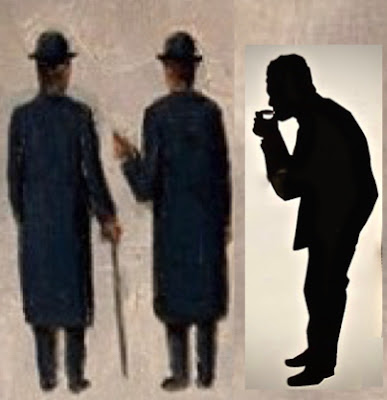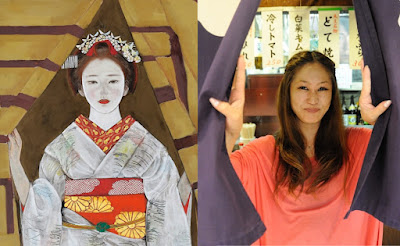I will be presenting at the 12th International Convention of Asian Scholars (ICAS), held August 24-28, 2021. The host is Kyoto Seika University but it will be a virtual event. The presentations have two parts. The first part is a pre-recorded 15-minute lecture available on-demand at the ICAS website (you must be registered for the conference to view the lectures). The second part is a live discussion session. While my paper has changed a bit since I submitted my proposal, here is the original abstract:
In Japan, food is prominent in documentaries, cooking shows, travel shows, variety shows, dramas, manga, anime, books, magazines, blogs, Facebook and Instagram. This food, not eaten but consumed, provides gratification and knowledge. Many of these media descriptions are set in izakaya (Japanese-style pub) and tachinomiya (Japanese standing bar) that serve B-kyu gurume (B-rank food)—comfort food and/or local food. These are fascinating shops and sites to explore the production (cooking) and consumption (eating) of food.
This presentation is a multimodal visual ethnography of a 40-year-old tachinomiya in Osaka called Tenbun. Tenbun features many kinds of food and drink, a lively and relaxed atmosphere and plenty of colorful characters including the owner, employees and regular customers. Based upon long-term patronage, focused participant-observation and photography, a photo exhibition and other post-fieldwork encounters, my analysis positions the research within the intersection of food anthropology and the popular Japanese “foodie” media. Matthew Longcore discusses how Anthony Bourdain, Gordon Ramsey and other Western food experts feature “ethnographic culinary adventures [that] bring food and film together for the enjoyment, entertainment, and enlightenment of foodies and anthropologists alike” (2019). Current popular TV series about food and drink including Yoshida Rui’s Sakaba hōrō-ki (“Bar Hopping Report,” BS-TBS) and Kodoku no Gurume (“The Solitary Gourmet,” TV Tokyo), and others, will be described and analyzed to show that media portrayals are another form of production, that of information and recreation, that is “good to think” (Levi-Strauss 1962), “communicated” (Barthes 1966; Dusselier 2009) and “shared among people” (Cheung 2002).
My video: available on demand before, during and after the conference until October 15.
My discussion session: Food, Taste and Memory
Saturday, August 28, 2021, 17:15-18:15 (Japan time).
Chair: Floper Gershwin Manuel, Assistant Professor, Central Luzon State University, Philippines
Food and Drink at a Japanese Standing Bar: An Appetizing Production
Presenter: Steven C. Fedorowicz – Kansai Gaidai University
White Rice vs. Dark Bread: Inheriting and Crafting Rural Identity, Local Heritage and Sustainable Future in China and Estonia
Presenter: Siyun Wu – Leiden University - Institute of Cultural Anthropology and Development Sociology
Farming Conditions of Draught Cattle in Western Japan During 19th Century
Presenter: Akiyo HERLEDANT-KUBO – INALCO
Conference information and a complete program schedule can be found at the ICAS website.
url: https://www.eventscribe.net/2021/ICAS12/
For more information about the Tenbun/tachinomiya project:
url: http://visualanthropologyofjapan.blogspot.com/2016/01/photo-exhibition-and-visual-ethnography.html
Even more on the project: https://visualanthropologyofjapan.blogspot.com/2020/12/behind-scenestenbun-closingpresentation.html
Explorations and experiments in visual representations - multimodality, sensory ethnography, reflexivity, autoethnographic vignettes, ethnographic photography and ba...

Monday, August 16, 2021
Friday, August 13, 2021
"When anthropological fieldwork is interrupted by a pandemic, what new opportunities arise from other avenues of inquiry?" (part 3) -and- "The Art of Conversation" / Tachinomiya for the common people
Matthew Demaio, in his recent article, Lenticular Research and the Possibilities of Digital Archival Methods, writes, "There is a mode of producing dual holographic images that give a viewer the impression of depth and movement called “lenticular printing.” To make lenticular images, you must first capture two images with a special lens and then print each on a sheet of plastic that has a series of lenses on the reverse..."
"I start with lenticular printing as a way to think about the possibilities and limits of anthropological research in contexts of instability and uncertainty. What does an anthropological inquiry look like when it is suddenly and unexpectedly bifurcated by a period of enforced distance and isolation?"
DeMaio, Matthew. 2021. “Lenticular Research and the Possibilities of Digital Archival Methods.” Anthropology News website, July 30, 2021.
url: https://www.anthropology-news.org/articles/lenticular-research-and-the-possibilities-of-digital-archival-methods/
Those of us who are not so high tech might come up with stuff like this...
In the spirit of fair use and creative commons, I am borrowing the image on the left ("The Art of Conversation" - original title "L’Art de la Conversation" 1963 by Belgian surrealist artist René Magritte) from the following source:
url: https://www.facebook.com/JadedInJapan/posts/3737914866308621
The image on the right is the (flipped) logo for the sign at 立ち呑み 庶民 (Tachi nomi shomin), "Tachinomi for common people."
url: http://tachinomishomin.com/index.html
As seen on a recent post on 大阪立ち呑み研究会 (Osaka Tachinomi Study Group on Facebook).
This VAoJ post is related to the Tenbun/tachinomiya project.
url: http://visualanthropologyofjapan.blogspot.com/2016/01/photo-exhibition-and-visual-ethnography.html
More on the project: https://visualanthropologyofjapan.blogspot.com/2020/12/behind-scenestenbun-closingpresentation.html
Special preview: I will be presenting more about the Tenbun/tachinomiya project at the upcoming 12th International Convention of Asia Scholars, August 24-28. More details to follow...
"I start with lenticular printing as a way to think about the possibilities and limits of anthropological research in contexts of instability and uncertainty. What does an anthropological inquiry look like when it is suddenly and unexpectedly bifurcated by a period of enforced distance and isolation?"
DeMaio, Matthew. 2021. “Lenticular Research and the Possibilities of Digital Archival Methods.” Anthropology News website, July 30, 2021.
url: https://www.anthropology-news.org/articles/lenticular-research-and-the-possibilities-of-digital-archival-methods/
Those of us who are not so high tech might come up with stuff like this...
In the spirit of fair use and creative commons, I am borrowing the image on the left ("The Art of Conversation" - original title "L’Art de la Conversation" 1963 by Belgian surrealist artist René Magritte) from the following source:
url: https://www.facebook.com/JadedInJapan/posts/3737914866308621
The image on the right is the (flipped) logo for the sign at 立ち呑み 庶民 (Tachi nomi shomin), "Tachinomi for common people."
url: http://tachinomishomin.com/index.html
As seen on a recent post on 大阪立ち呑み研究会 (Osaka Tachinomi Study Group on Facebook).
This VAoJ post is related to the Tenbun/tachinomiya project.
url: http://visualanthropologyofjapan.blogspot.com/2016/01/photo-exhibition-and-visual-ethnography.html
More on the project: https://visualanthropologyofjapan.blogspot.com/2020/12/behind-scenestenbun-closingpresentation.html
Special preview: I will be presenting more about the Tenbun/tachinomiya project at the upcoming 12th International Convention of Asia Scholars, August 24-28. More details to follow...
Wednesday, August 11, 2021
"When anthropological fieldwork is interrupted by a pandemic, what new opportunities arise from other avenues of inquiry?" (part 2) -and- Tachinomiya and noren for the common people...
Matthew Demaio, in his recent article, Lenticular Research and the Possibilities of Digital Archival Methods, writes, "There is a mode of producing dual holographic images that give a viewer the impression of depth and movement called “lenticular printing.” To make lenticular images, you must first capture two images with a special lens and then print each on a sheet of plastic that has a series of lenses on the reverse..."
"I start with lenticular printing as a way to think about the possibilities and limits of anthropological research in contexts of instability and uncertainty. What does an anthropological inquiry look like when it is suddenly and unexpectedly bifurcated by a period of enforced distance and isolation?"
DeMaio, Matthew. 2021. “Lenticular Research and the Possibilities of Digital Archival Methods.” Anthropology News website, July 30, 2021.
url: https://www.anthropology-news.org/articles/lenticular-research-and-the-possibilities-of-digital-archival-methods/
Those of us who are not so high tech might come up with stuff like this...
In the spirit of fair use and creative commons, I am borrowing the image on the right (Ishimoto Sho "Noren" Showa 45 [1970]) from the following source:
Sekisho Art Museum: 100th Anniversary Retrospective Exhibition Sho Ishimoto
url: http://www.sekisho-art-museum.jp/seitan100ishimoto?fbclid=IwAR0cfCMgukwkt3VDTPdGRewNalnxeejvf41FEiPx1Ui3HUba1uud81h0fFo
Flyer for the exhibition: http://www.sekisho-art-museum.jp/wp-content/uploads/2020/11/%E7%94%9F%E8%AA%95100%E5%B9%B4%E7%9F%B3%E6%9C%AC%E6%AD%A3%E4%BA%88%E5%91%8A%E3%83%81%E3%83%A9%E3%82%B7.pdf
The image on the left is the logo for the sign at 立ち呑み 庶民 (Tachi nomi shomin), "Tachinomi for common people."
url: http://tachinomishomin.com/index.html
As seen on a recent post on 大阪立ち呑み研究会 (Osaka Tachinomi Study Group on Facebook).
This VAoJ post is related to the Tenbun/tachinomiya project.
url: http://visualanthropologyofjapan.blogspot.com/2016/01/photo-exhibition-and-visual-ethnography.html
More on the project: https://visualanthropologyofjapan.blogspot.com/2020/12/behind-scenestenbun-closingpresentation.html
Special preview: I will be presenting more about the Tenbun/tachinomiya project at the upcoming 12th International Convention of Asia Scholars, August 24-28. More details to follow...
"I start with lenticular printing as a way to think about the possibilities and limits of anthropological research in contexts of instability and uncertainty. What does an anthropological inquiry look like when it is suddenly and unexpectedly bifurcated by a period of enforced distance and isolation?"
DeMaio, Matthew. 2021. “Lenticular Research and the Possibilities of Digital Archival Methods.” Anthropology News website, July 30, 2021.
url: https://www.anthropology-news.org/articles/lenticular-research-and-the-possibilities-of-digital-archival-methods/
Those of us who are not so high tech might come up with stuff like this...
In the spirit of fair use and creative commons, I am borrowing the image on the right (Ishimoto Sho "Noren" Showa 45 [1970]) from the following source:
Sekisho Art Museum: 100th Anniversary Retrospective Exhibition Sho Ishimoto
url: http://www.sekisho-art-museum.jp/seitan100ishimoto?fbclid=IwAR0cfCMgukwkt3VDTPdGRewNalnxeejvf41FEiPx1Ui3HUba1uud81h0fFo
Flyer for the exhibition: http://www.sekisho-art-museum.jp/wp-content/uploads/2020/11/%E7%94%9F%E8%AA%95100%E5%B9%B4%E7%9F%B3%E6%9C%AC%E6%AD%A3%E4%BA%88%E5%91%8A%E3%83%81%E3%83%A9%E3%82%B7.pdf
The image on the left is the logo for the sign at 立ち呑み 庶民 (Tachi nomi shomin), "Tachinomi for common people."
url: http://tachinomishomin.com/index.html
As seen on a recent post on 大阪立ち呑み研究会 (Osaka Tachinomi Study Group on Facebook).
This VAoJ post is related to the Tenbun/tachinomiya project.
url: http://visualanthropologyofjapan.blogspot.com/2016/01/photo-exhibition-and-visual-ethnography.html
More on the project: https://visualanthropologyofjapan.blogspot.com/2020/12/behind-scenestenbun-closingpresentation.html
Special preview: I will be presenting more about the Tenbun/tachinomiya project at the upcoming 12th International Convention of Asia Scholars, August 24-28. More details to follow...
Tuesday, August 3, 2021
"When anthropological fieldwork is interrupted by a pandemic, what new opportunities arise from other avenues of inquiry?" (part 1) -and- Through the noren, then and now...
Matthew Demaio, in his recent article, Lenticular Research and the Possibilities of Digital Archival Methods, writes, "There is a mode of producing dual holographic images that give a viewer the impression of depth and movement called “lenticular printing.” To make lenticular images, you must first capture two images with a special lens and then print each on a sheet of plastic that has a series of lenses on the reverse..."
"I start with lenticular printing as a way to think about the possibilities and limits of anthropological research in contexts of instability and uncertainty. What does an anthropological inquiry look like when it is suddenly and unexpectedly bifurcated by a period of enforced distance and isolation?"
DeMaio, Matthew. 2021. “Lenticular Research and the Possibilities of Digital Archival Methods.” Anthropology News website, July 30, 2021.
url: https://www.anthropology-news.org/articles/lenticular-research-and-the-possibilities-of-digital-archival-methods/
Those of us who are not so high tech might come up with something like this...
In the spirit of fair use and creative commons, I am borrowing the image on the left (Ishimoto Sho "Noren" Showa 45 [1970]) from the following source:
Sekisho Art Museum: 100th Anniversary Retrospective Exhibition Sho Ishimoto
url: http://www.sekisho-art-museum.jp/seitan100ishimoto?fbclid=IwAR0cfCMgukwkt3VDTPdGRewNalnxeejvf41FEiPx1Ui3HUba1uud81h0fFo
Flyer for the exhibition: http://www.sekisho-art-museum.jp/wp-content/uploads/2020/11/%E7%94%9F%E8%AA%95100%E5%B9%B4%E7%9F%B3%E6%9C%AC%E6%AD%A3%E4%BA%88%E5%91%8A%E3%83%81%E3%83%A9%E3%82%B7.pdf
The image from the right (appearing for the first time online) is my own photograph from the Tenbun/tachinomiya project.
url: http://visualanthropologyofjapan.blogspot.com/2016/01/photo-exhibition-and-visual-ethnography.html
More on the project: https://visualanthropologyofjapan.blogspot.com/2020/12/behind-scenestenbun-closingpresentation.html
Special preview: I will be presenting more about the Tenbun/tachinomiya project at the upcoming 12th International Convention of Asia Scholars, August 24-28. More details to follow...
"I start with lenticular printing as a way to think about the possibilities and limits of anthropological research in contexts of instability and uncertainty. What does an anthropological inquiry look like when it is suddenly and unexpectedly bifurcated by a period of enforced distance and isolation?"
DeMaio, Matthew. 2021. “Lenticular Research and the Possibilities of Digital Archival Methods.” Anthropology News website, July 30, 2021.
url: https://www.anthropology-news.org/articles/lenticular-research-and-the-possibilities-of-digital-archival-methods/
Those of us who are not so high tech might come up with something like this...
In the spirit of fair use and creative commons, I am borrowing the image on the left (Ishimoto Sho "Noren" Showa 45 [1970]) from the following source:
Sekisho Art Museum: 100th Anniversary Retrospective Exhibition Sho Ishimoto
url: http://www.sekisho-art-museum.jp/seitan100ishimoto?fbclid=IwAR0cfCMgukwkt3VDTPdGRewNalnxeejvf41FEiPx1Ui3HUba1uud81h0fFo
Flyer for the exhibition: http://www.sekisho-art-museum.jp/wp-content/uploads/2020/11/%E7%94%9F%E8%AA%95100%E5%B9%B4%E7%9F%B3%E6%9C%AC%E6%AD%A3%E4%BA%88%E5%91%8A%E3%83%81%E3%83%A9%E3%82%B7.pdf
The image from the right (appearing for the first time online) is my own photograph from the Tenbun/tachinomiya project.
url: http://visualanthropologyofjapan.blogspot.com/2016/01/photo-exhibition-and-visual-ethnography.html
More on the project: https://visualanthropologyofjapan.blogspot.com/2020/12/behind-scenestenbun-closingpresentation.html
Special preview: I will be presenting more about the Tenbun/tachinomiya project at the upcoming 12th International Convention of Asia Scholars, August 24-28. More details to follow...
Subscribe to:
Posts (Atom)





